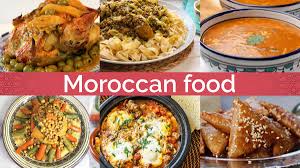Exploring the Flavours of Morocco: A Culinary Journey
Moroccan cuisine is a vibrant tapestry of flavours, colours, and aromas that reflect the country’s diverse history and cultural influences. From savoury tagines to sweet pastries, here are some typical Moroccan dishes that will tantalise your taste buds:
Tagine
Tagine is perhaps the most iconic Moroccan dish, named after the earthenware pot in which it is cooked. This slow-cooked stew features a variety of ingredients such as tender meat (often lamb or chicken), vegetables, dried fruits, and aromatic spices like cumin, cinnamon, and saffron.
Couscous
Couscous is a staple in Moroccan cuisine, made from steamed semolina grains typically served with a rich vegetable or meat stew. The fluffy texture of couscous pairs perfectly with the hearty flavours of the accompanying sauce, creating a comforting and satisfying meal.
Pastilla
Pastilla is a unique Moroccan dish that combines sweet and savoury flavours in a delicate pastry. Traditionally filled with shredded pigeon meat, almonds, eggs, and aromatic spices like cinnamon and powdered sugar, pastilla is a true culinary delight that showcases Morocco’s culinary artistry.
Harira
Harira is a traditional Moroccan soup that is often enjoyed during Ramadan to break the fast. This hearty soup features a tomato base with lentils, chickpeas, vermicelli noodles, and a blend of spices like ginger and turmeric. Harira is both nourishing and flavourful.
Mint Tea
No exploration of Moroccan cuisine would be complete without mentioning mint tea—Morocco’s national drink. This refreshing beverage combines green tea leaves with fresh mint leaves and sugar to create a sweet and aromatic infusion that symbolises hospitality and friendship in Moroccan culture.
These are just a few examples of the diverse and delicious dishes that make up Moroccan cuisine. Each bite tells a story of tradition, history, and passion for culinary excellence—a true feast for both the palate and the soul.
Eight Delightful Aspects of Traditional Moroccan Cuisine
- 1. Rich in Flavour
- 2. Healthy Ingredients
- 3. Cultural Experience
- 4. Versatile Options
- 5. Exotic Ingredients
- 6. Sharing Tradition
- 7. Vegetarian-Friendly
- 8. Sweet Endings
Potential Drawbacks of Traditional Moroccan Cuisine
- Some Moroccan dishes can be quite heavy and rich, which may not suit everyone’s taste or dietary preferences.
- Certain traditional Moroccan dishes require lengthy preparation and cooking times, making them less suitable for quick meals.
- The use of exotic spices in Moroccan cuisine may not appeal to individuals who prefer milder flavours.
- Authentic Moroccan ingredients can be challenging to find in some regions, limiting access to traditional recipes.
- Moroccan dishes often contain nuts or gluten, which could pose a challenge for those with allergies or dietary restrictions.
1. Rich in Flavour
Moroccan dishes are a culinary treasure trove, known for their richness in flavour. Each bite of a typical Moroccan dish is a symphony of aromatic spices and bold flavours that awaken the senses and transport you to the bustling markets and vibrant streets of Morocco. From the warm notes of cumin and cinnamon to the subtle sweetness of dried fruits, every ingredient in Moroccan cuisine plays a vital role in creating a sensory delight that leaves a lasting impression on your taste buds.
2. Healthy Ingredients
Many Moroccan dishes stand out for their emphasis on healthy ingredients, incorporating a variety of fresh vegetables, lean meats, and nutritious grains such as couscous. This focus on wholesome components not only enhances the flavours and textures of the dishes but also ensures a balanced and nutritious meal. By utilising natural, unprocessed ingredients, Moroccan cuisine promotes a healthy lifestyle while delivering delicious and satisfying culinary experiences.
3. Cultural Experience
Sampling typical Moroccan dishes offers more than just a gastronomic delight—it provides a cultural experience that immerses you in the country’s rich culinary heritage and traditions. Each bite of a traditional Moroccan dish is a journey through centuries of history, blending flavours and ingredients that have been passed down through generations. From the intricate spice blends to the communal dining rituals, indulging in these dishes is a gateway to understanding Morocco’s vibrant culture and the deep-rooted significance of food in its society.
4. Versatile Options
Moroccan cuisine shines with its versatility, offering a spectrum of flavours and textures to cater to a wide range of tastes. Whether you crave the comforting warmth of a hearty tagine or prefer the freshness of a light and zesty salad, Moroccan dishes present an array of options to satisfy every palate. This culinary diversity allows diners to explore and appreciate the richness of Moroccan gastronomy, making it a delightful experience for both adventurous food enthusiasts and those seeking familiar comforts in their meals.
5. Exotic Ingredients
One of the enticing aspects of typical Moroccan dishes is the use of exotic ingredients that elevate the flavours to a whole new level. From the tangy brightness of preserved lemons to the nutty richness of argan oil and the complex spice blend of ras el hanout, these unique additions bring a depth and complexity to Moroccan recipes that are truly unparalleled. Exploring these ingredients opens up a world of culinary possibilities and allows for a sensory journey through the vibrant tastes of Morocco.
6. Sharing Tradition
In Moroccan culinary tradition, the act of sharing a meal goes beyond nourishment—it fosters a deep sense of community and kinship. The communal dining experience, where dishes are placed at the centre of the table for all to partake in, creates an atmosphere of togetherness and shared enjoyment. This tradition not only enhances the flavours of the food but also strengthens bonds between diners, embodying the spirit of unity and hospitality that is intrinsic to Moroccan culture.
7. Vegetarian-Friendly
Moroccan cuisine shines as a vegetarian-friendly culinary delight, offering a plethora of plant-based options that showcase the country’s rich flavours and diverse ingredients. From fragrant vegetable tagines to hearty lentil soups, Morocco effortlessly caters to vegetarians seeking delicious and satisfying meals. The abundance of fresh produce, aromatic spices, and traditional cooking techniques ensure that every vegetarian dish in Morocco is a true celebration of flavour and creativity.
8. Sweet Endings
Indulge in the sweet endings of a Moroccan meal and experience a delightful journey through decadent desserts such as baklava and chebakia. These intricate treats not only satisfy the sweet tooth but also showcase Morocco’s rich culinary heritage and love for creating intricate and flavourful sweets. From layers of flaky pastry filled with nuts and honey in baklava to the delicate, flower-shaped chebakia coated in sesame seeds and honey, these desserts are a testament to Morocco’s passion for creating unforgettable culinary experiences.
Some Moroccan dishes can be quite heavy and rich, which may not suit everyone’s taste or dietary preferences.
Some Moroccan dishes can be quite heavy and rich, which may not suit everyone’s taste or dietary preferences. The richness of ingredients like lamb, butter, and spices can be overwhelming for those who prefer lighter or simpler flavours. Individuals with dietary restrictions or preferences for low-fat or low-sodium meals may find traditional Moroccan cuisine challenging to accommodate. It’s important to be mindful of these factors when exploring Moroccan dishes to ensure a dining experience that aligns with personal tastes and health goals.
Certain traditional Moroccan dishes require lengthy preparation and cooking times, making them less suitable for quick meals.
Certain traditional Moroccan dishes embody a culinary tradition that values patience and dedication in the kitchen. With intricate flavour profiles and slow-cooking techniques, these dishes demand significant preparation and cooking times, rendering them less ideal for quick meals. From the slow simmering of tagines to the delicate layering of ingredients in pastillas, these time-honoured recipes require a commitment to the process, allowing flavours to develop harmoniously over time. While these dishes may not be suited for rushed mealtimes, their depth of taste and cultural significance make them well worth the wait for those seeking an authentic Moroccan dining experience.
The use of exotic spices in Moroccan cuisine may not appeal to individuals who prefer milder flavours.
The rich and diverse flavours of Moroccan cuisine, characterised by the use of exotic spices such as cumin, cinnamon, and saffron, may not suit individuals who have a preference for milder tastes. The bold and aromatic nature of these spices can sometimes be overpowering for those accustomed to more subtle flavours. However, for those willing to embark on a culinary adventure, exploring the unique blend of spices in Moroccan dishes offers a sensory journey that unveils the depth and complexity of this vibrant culinary tradition.
Authentic Moroccan ingredients can be challenging to find in some regions, limiting access to traditional recipes.
Accessing authentic Moroccan ingredients can pose a challenge in certain regions, hindering the ability to recreate traditional Moroccan dishes faithfully. The unique spices, herbs, and specialty items essential to Moroccan cuisine may not be readily available in all areas, making it difficult for aspiring chefs to capture the true essence of these flavourful recipes. This limitation highlights the importance of sourcing quality ingredients to truly experience the rich and diverse flavours of Moroccan gastronomy.
Moroccan dishes often contain nuts or gluten, which could pose a challenge for those with allergies or dietary restrictions.
Moroccan cuisine, known for its rich and diverse flavours, may present a challenge for individuals with allergies or dietary restrictions due to the common use of nuts and gluten in many traditional dishes. Nuts such as almonds, walnuts, and pistachios are frequently used in Moroccan recipes to add texture and depth of flavour, while wheat-based ingredients like couscous and bread are staples of the cuisine. For those with allergies or sensitivities to these ingredients, navigating Moroccan menus and preparing authentic dishes at home may require careful consideration and alternative ingredient choices to ensure a safe and enjoyable dining experience.




